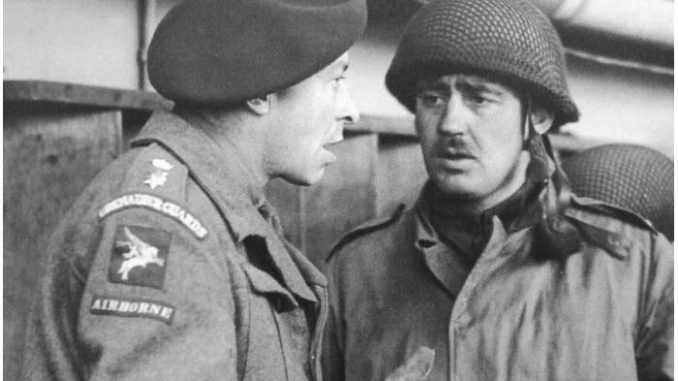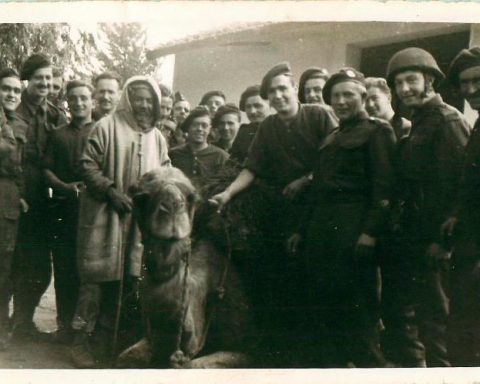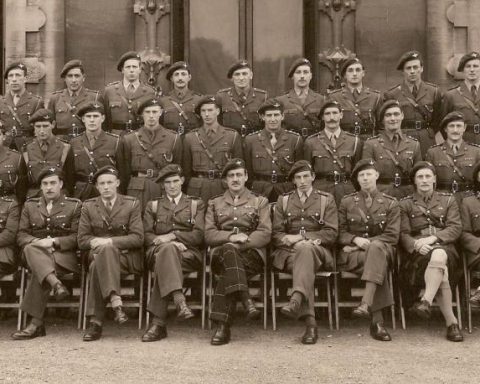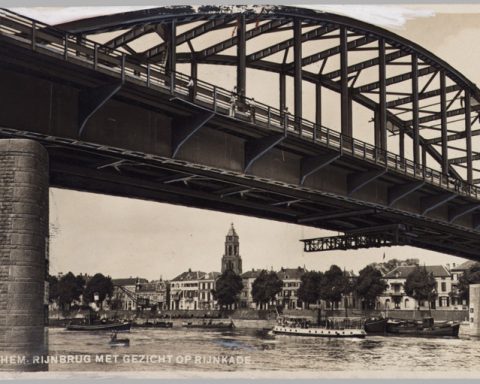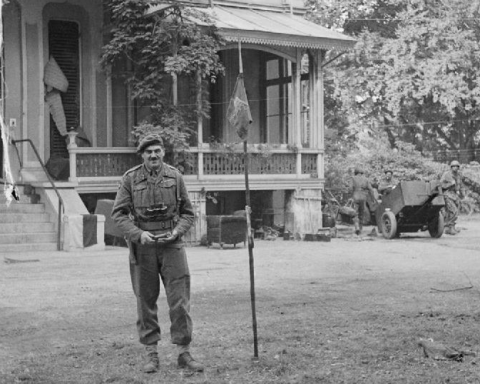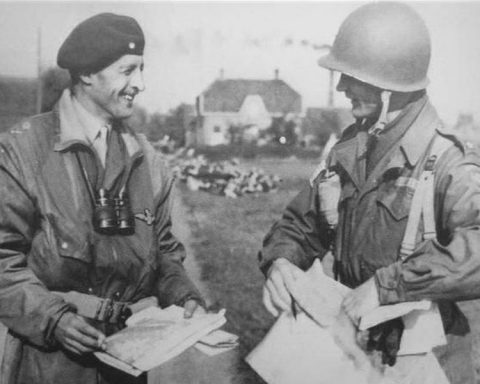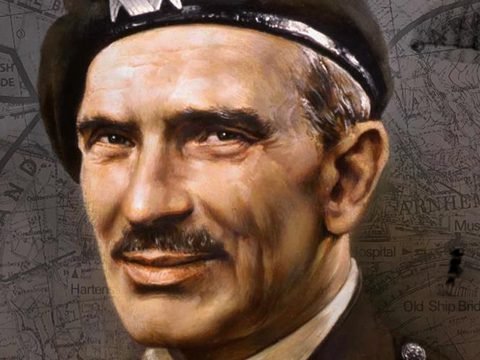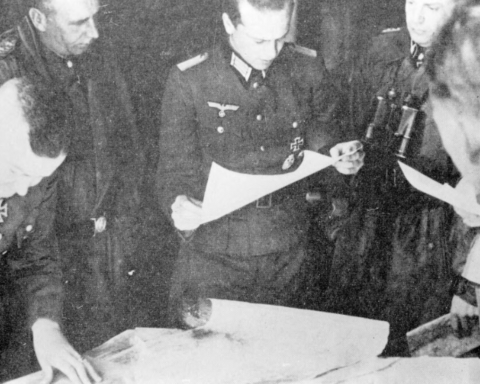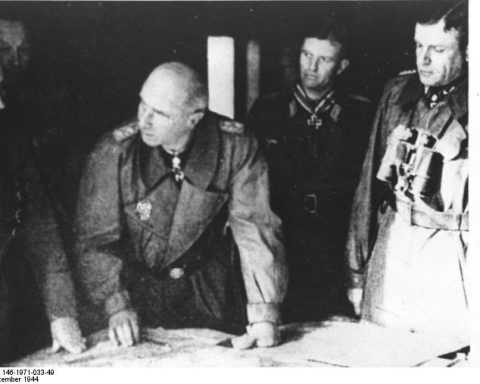Lieutenant Colonel John Frost is the face of the Battle of Arnhem. Frost led the 2nd Battalion of the 1st Parachute Brigade during the battle. From Sunday, September 17 to Wednesday, September 20, the paratroopers of this battalion occupied the northern ramp of the Rhine Bridge before they were forced to stop fighting.
Born in 1912, John Frost was a professional soldier stationed in Iraq at the beginning of World War II. In 1940 Frost returned to Great Britain, where he trained as a Special Air Service. In 1941, Frost enlisted in the British Airborne Division just established by General Boy Browning.
While Frost was still training with the first paratroopers, the British army command knocked on General Browning’s door. They needed a hundred paratroopers for a daring attack on the French coast.
Bruneval
British reconnaissance aircraft had seen a German Würzburg radar installation near the French village Bruneval in Normandy, near the coast. Because the British wanted to know how far the Germans were with the development of radar, the army leadership had thought that British paratroopers had to capture the radar installation by air landing, including a German operator.
From the beach, the British soldiers would then be picked up by fast motor boats for the trip to England.
Browning had just finished a first battalion of paratroopers who had completed their training, but he preferred not to use it for the operation. He therefore chose a company from the second battalion, which consisted of fresh recruits who had just started their training.
This company was led by John Frost, who had also just started his training as a parachutist. The Frost Company, Frost still in the rank of Major, spent two months practicing with the RAF and the Royal Navy.
The operation was a great success. While most of Frost’s men kept about 200 German soldiers at bay, a few soldiers dismantled the radar installation. The radar operator was taken prisoner of war. The British returned to England with only two deaths and six injuries.
Frost was widely commended in the British press as the unit’s commander. Frost was even invited to Winston Churchill to talk about the operation.
Arnhem
After his adventure in Bruneval, Frost also fought in Tunisia and was part of the British troops that landed in Sicily. Frost was promoted to the rank of Lieutenant Colonel here.
In mid-1944, the 1st British Airborne Division was at full strength. To the disappointment of the division, they were not deployed during the D-Day landings in Normandy. In the following months, one plan after another to deploy the division was cancelled. But in September 1944 the time had come: Operation Market Garden would conquer a fast route to the heart of Germany.
General Roy Urquhart, who was responsible for working out the Arnhem part of the operation, chose the Frost battalion to secure the three crossings over the Rhine.
In addition to the Rhine Bridge in the center of Arnhem, Frost was also commissioned to secure the railway bridge at Oosterbeek and the old ship bridge on the Rijnkade.
Urquhart chose Frost because of the experience Frost had. In addition, Frost was known as a go-getter who did everything he could to achieve his goal. So Frost was the right man to conquer the bridges.
The Frost battalion was one of the three battalions that advanced immediately after the airborne landing at Wolfheze in the direction of Arnhem. The 1st Battalion led by Colonel Dobie and the 3rd Battalion led by Colonel Fitch were stopped during their advance to Arnhem by German troops at the Utrechtseweg and the Amsterdamseweg.
However, Frost’s predetermined route led along the Rhine and Frost encountered few German troops in its advance along the Rhine. But Frost only partially succeeded in the assignment he had been given. The railway bridge at Oosterbeek was blown up by the Germans while the first British ran across the bridge to the south and the ship bridge had sailed to the south bank by the Germans.
Frost also only partially succeeded in conquering the Rhine Bridge. Because the Germans fiercely defended the bridge from the south side, Frost and his battalion only managed to get hold of the north side.
Around the bridge, Frost created a defensive position and waited for the British ground forces to arrive from the south within 48 hours. It turned out differently. The advance of the ground troops was much slower than planned and the rest of the British airborne troops did not get any further than the Elisabeth Gasthuis before they were pushed back to Oosterbeek.
Despite a fierce three-day battle, Frost and his men had to stop fighting at the bridge on the evening of September 20. All the while they had resisted German attacks with tanks and Sturmgeschütze, but on Wednesday September 20 there was nothing left of the British positions at the bridge.
Frost himself was injured in the leg that afternoon. He was talking outside with one of his commanders when a mortar bomb exploded nearby. Initially, Frost relieved the pain as he continued to lead the defense, but that evening he handed over command to Major Freddie Gough. At that time, the British occupied only a few houses near the bridge.
Most houses in the area were burned down by the Germans to drive out the airborne troops.
After the battle at the bridge came to an end, Frost was taken to the Elisabeth Gasthuis along with the other British wounded. World War II ended for John Frost.
“The German SS men were very polite and complimentary about the fighting,” said Frost. “But the bitterness that we had to stop fighting was no less of a problem.”
Prisoner of War
Before the Germans took him prisoner of war, John Frost had removed the insignia of his uniform. Frost hoped that in this way he would not be recognizable as the officer in charge of the British troops at the bridge. But the Germans soon discovered that John Frost was a colonel.
After a short stay at the Elisabeth Gasthuis, Frost was eventually transported to Spangenburg, a prisoner of war camp for officers. Frost made plans to escape here, but they were thwarted by the fact that the wound on his leg opened up again.
For medical treatment, Frost was subsequently placed in a prisoner of war hospital in Obermansfeldt. It was here that Frost was liberated in March 1945 by the American troops of General Patton.
Frost was very impressed by the well-oiled machine that was General Patton’s army. Frost, still in possession of his red beret, was therefore recognizable to the Americans as an ‘Arnhem veteran’. In his autobiography A drop too many , Frost describes how he had the same type of conversation with Patton’s soldiers on several occasions.
Frost: “All the ranks of this army said the same when they saw my red beret: Arnhem huh? We would have broken through to reach you. Yes, sir. We would have reached you.”
After the war
After World War II ended, John Frost remained active in the British Army. Among other things, he was a staff officer in the Gurkha division and commanded British troops in Malta and Libya.
In 1977 plans arose to name the Rhine Bridge in Arnhem after John Frost. Frost himself thought it was too much honor, especially because the British had lost the Battle of Arnhem. But he was convinced by his old buddy Freddie Gough.
In 1979, Frost retired from the military at the age of 67 and became a rancher in rural England. John Frost died on May 21, 1993 at the age of eighty. The Rhine Bridge in Arnhem lives on as the John Frost Bridge.

